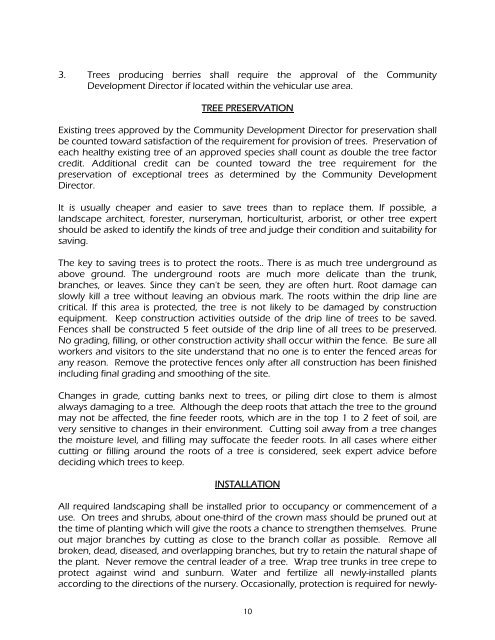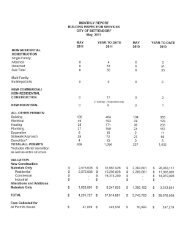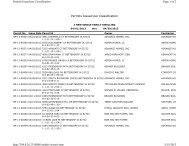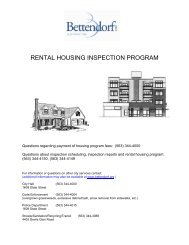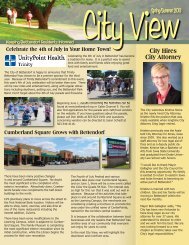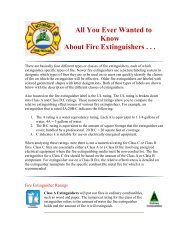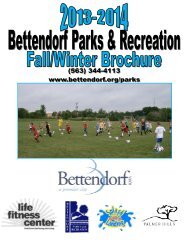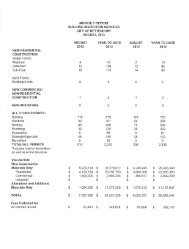Landscape Handbook - City of Bettendorf
Landscape Handbook - City of Bettendorf
Landscape Handbook - City of Bettendorf
Create successful ePaper yourself
Turn your PDF publications into a flip-book with our unique Google optimized e-Paper software.
3. Trees producing berries shall require the approval <strong>of</strong> the CommunityDevelopment Director if located within the vehicular use area.TREE PRESERVATIONExisting trees approved by the Community Development Director for preservation shallbe counted toward satisfaction <strong>of</strong> the requirement for provision <strong>of</strong> trees. Preservation <strong>of</strong>each healthy existing tree <strong>of</strong> an approved species shall count as double the tree factorcredit. Additional credit can be counted toward the tree requirement for thepreservation <strong>of</strong> exceptional trees as determined by the Community DevelopmentDirector.It is usually cheaper and easier to save trees than to replace them. If possible, alandscape architect, forester, nurseryman, horticulturist, arborist, or other tree expertshould be asked to identify the kinds <strong>of</strong> tree and judge their condition and suitability forsaving.The key to saving trees is to protect the roots.. There is as much tree underground asabove ground. The underground roots are much more delicate than the trunk,branches, or leaves. Since they can't be seen, they are <strong>of</strong>ten hurt. Root damage canslowly kill a tree without leaving an obvious mark. The roots within the drip line arecritical. If this area is protected, the tree is not likely to be damaged by constructionequipment. Keep construction activities outside <strong>of</strong> the drip line <strong>of</strong> trees to be saved.Fences shall be constructed 5 feet outside <strong>of</strong> the drip line <strong>of</strong> all trees to be preserved.No grading, filling, or other construction activity shall occur within the fence. Be sure allworkers and visitors to the site understand that no one is to enter the fenced areas forany reason. Remove the protective fences only after all construction has been finishedincluding final grading and smoothing <strong>of</strong> the site.Changes in grade, cutting banks next to trees, or piling dirt close to them is almostalways damaging to a tree. Although the deep roots that attach the tree to the groundmay not be affected, the fine feeder roots, which are in the top 1 to 2 feet <strong>of</strong> soil, arevery sensitive to changes in their environment. Cutting soil away from a tree changesthe moisture level, and filling may suffocate the feeder roots. In all cases where eithercutting or filling around the roots <strong>of</strong> a tree is considered, seek expert advice beforedeciding which trees to keep.INSTALLATIONAll required landscaping shall be installed prior to occupancy or commencement <strong>of</strong> ause. On trees and shrubs, about one-third <strong>of</strong> the crown mass should be pruned out atthe time <strong>of</strong> planting which will give the roots a chance to strengthen themselves. Pruneout major branches by cutting as close to the branch collar as possible. Remove allbroken, dead, diseased, and overlapping branches, but try to retain the natural shape <strong>of</strong>the plant. Never remove the central leader <strong>of</strong> a tree. Wrap tree trunks in tree crepe toprotect against wind and sunburn. Water and fertilize all newly-installed plantsaccording to the directions <strong>of</strong> the nursery. Occasionally, protection is required for newly-10


